The 157th New York and Dingle's Mill: A Final Fight in South Carolina
On one of the last days of the Civil War, Captain William Saxton of the 157th New York recorded his impressions of the April 9, 1865, fight at Dingle's Mill, South Carolina. His regiment, formerly part of the 11th Corps, had been pummeled at both Chancellorsville and Gettysburg before being sent to South Carolina in the summer of 1863. They were a veteran unit and when they deployed through the swamp at Dingle's Mill, Captain Saxton spied a pair of Confederate artillery pieces in his front and resolved to take them.
"I immediately formed my company in line, a few of the 56th New York boys falling in line with me, and marched them hurriedly to the edge of the woods, showed them the guns, then said, “Boys, let’s take them. Now, every man for himself as fast as you can go. Forward march!” And away we went. How rapidly a man’s thoughts will come to him under certain circumstances. I remember I thought as we were running forward that the muzzles of those guns were large enough for one to crawl into and I expected every second to see them fire into our faces. The distance was perhaps 200 yards but the Johnnies had gotten scared and attempted to hitch their horses to those guns and haul them off, but we were too near them and they cut the traces of those that were hitched and away they went. Their traces were cotton ropes. Some ran up the road west, some climbed the road fence and scattered into a field north. A squad of cavalry was in the road only a few rods away and as we rushed over that little fort, they all fled up the road. I was among the first to arrive and shook hands with one of the 56th New York boys across one of the cannons," he wrote.
These diary entries from Captain William Saxton, Co. C, 157th N.Y. saw publication in the January 17 & 24, 1902, editions of the Edgar Post published in Edgar, Nebraska.
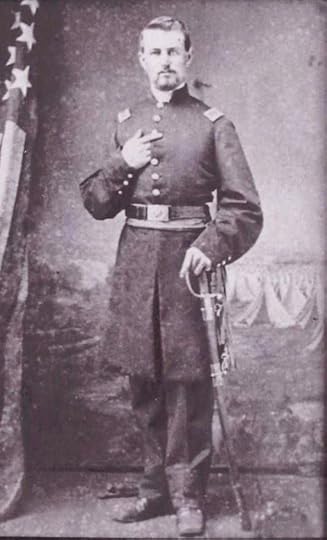 Captain William Saxton, Co. C, 157th New York Volunteers was a veteran of hard fighting at Chancellorsville and Gettysburg as well as service in South Carolina and along the Florida coast. The April 9, 1865, fight at Dingle's Mill near Sumter, South Carolina was the regiment's last engagement of the Civil War.
Captain William Saxton, Co. C, 157th New York Volunteers was a veteran of hard fighting at Chancellorsville and Gettysburg as well as service in South Carolina and along the Florida coast. The April 9, 1865, fight at Dingle's Mill near Sumter, South Carolina was the regiment's last engagement of the Civil War.
April 5, 1865: GeneralE.E. Potter was in command of this provisional division which was composed oftwo brigades. Adjutant Baldwin of our regiment was A.A.A.G. and LieutenantCampbell was acting ordnance officer on General Potter’s staff. The firstbrigade was commanded by Colonel Brown of our regiment; the second brigade byColonel Edward N. Hallowell of the 54th Massachusetts.
Two companiesof our regiment were left at Georgetown under command of Major Place to guardthe post and the two companies (B and D) of the 56th New York wereassigned to duty with us and Lieutenant Colonel Carmichael commanded theregiment. The provisional division consisted of about 4,000 men of allbranches, infantry, artillery, and cavalry.
At 8 a.m., thecolumn started and marched northwest parallel to and south of the Black Riverthrough a level wooded country towards Kingstree. Before going far, the columnwas halted and all who thought they would not be able to endure a long marchwere allowed to return to Georgetown. We made a march of about 18 miles thatnight and at night three or four Rebels were captured by our pickets.
April 6, 1865: Startedat 6:30 [a.m.] and marched through the same kind of country. The weather isgetting hot again. Camp near the Black River about seven miles from Kingstree,having marched about 20 miles. I was brigade officer of the day and had chargeof the pickets at night.
April 7, 1865: On themove again at 7:30 [a.m.]. The Johnnies are accumulating in our front andharass us a little. They burned the bridge over Black River at Kingstree. Wekept to the left and passed Kingstree on our right, marching toward Sumter. Thecountry is more open and a wealthier class of people live here when they are athome. Camped ten miles beyond Kingstree.
April 8, 1865: Startedat the usual hour, 6:30 [a.m.] in the rain bit it cleared off before noon.Marched 20 miles, forded two streams, and camped at night near the littlesummer village of Manning. A dastardly act was committed here by the enemy’scavalry. We had a small detachment of the 4th Massachusetts Cavalryalong with us. In coming into the village on the advance, this squad of cavalrychased the Rebel cavalry out. One of the Rebels, finding himself hotly pressed,turned and held up his hands in token of surrender. Private Elias B. Pratt ofCo. C advanced to receive him and, anticipating no danger, when nearly to hisside the Rebel dropped his hands, seized his revolver, and shot Pratt in theface, killing him instantly. The Rebel then put the spurs to his horse andescaped. In the running fight that ensured, one of the Johnnie’s saddles wasemptied. This was the most dastardly act that came within my personal knowledgeduring the war.
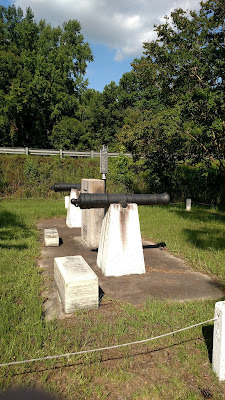 These are two cannons placed in their approximate positions at Dingle's Mill, an almost forgotten battlefield near Sumter, South Carolina. I visited the site, along along SC 521, in June of 2020.
These are two cannons placed in their approximate positions at Dingle's Mill, an almost forgotten battlefield near Sumter, South Carolina. I visited the site, along along SC 521, in June of 2020. April 9, 1865: Startedat 6:30 [a.m.] and marched rapidly all the forenoon. A number of cotton ginsand pressed were burned en route. We marched 14 miles in the forenoon and atnoon came to Dingle’s Mill where the road crossed a wide swamp with a streamflowing through the middle. The Rebels had town up the bridge across thisstream and flooded the swamp by cutting the dam to the right of the road. Theyhad erected a redoubt on a little rise of ground across the road on the westside of the swamp and as we approached, they sent a few solid shots across atus. General Potter halted the column out of range and gave the tired troops achance to eat their dinners.
After an hour’snooning, the 157th New York and 107th Ohio were ordered to flank the Johnnies out of their chosen position. ColonelCarmichael took our regiment and the two companies of the 56th NewYork to the left about a fourth of a mile and then turned west, parallel to theroad, marched down to the edge of that thickly wooded tangled swamp, halted,and had the officer’s call sounded.
He then toldus that we were to wade through that swamp and drive the enemy from theirposition. He said according to the best information obtainable; the swamp wasfrom a mile to a mile and a half in width and in places it would be waist deep.He instructed the company commanders to see that the men kept their ammunitiondry and have it ready for immediate use.
The difficultiesin crossing the swamp under the most favorable circumstances would requireconsiderable time and of necessity the regiment would become considerablystrung out as we would march by column of fours, left in front. If the enemystubbornly resisted our advance, it would take still longer time. In that swampand woods it would be impossible for the commander of the regiment to have aneye on the whole command and therefore each company commander (and especiallythose in the rear) must see to his own company. When we struck the hard groundon the other side, each must handle it as his best judgment would indicatewould be best in routing the enemy.
The order toadvance was then given. The marching of the regiment left in front brought Co.I in the lead and I do not recollect the order in which the other companiescame. My company was near the rear of the column, the two companies of the 56thNew York were ahead of me. As we entered the chilly waters of that swamp, whata shudder ran through our bodies! It was a dense wood with fallen logs andunderbrush with innumerable climbing, clinging, thorny vines extending from thelimbs of the trees to the ground. The natural obstructions to our progress weregreat and as before stated, the swamp had been flooded and the water and mirewere from knee to thigh deep as we floundered along.
Our progresswas naturally slow and the distance seemed longer than it actually was. Sometimearound 4 o’clock Co. I ran afoul of the enemy’s skirmishers along the edge ofthe woods on the west side and the firing at once became rapid and severe. Asthe head of the column emerged from the swamp while still in the woods, itdeflected to the right towards the road. Word was passed back for the othercompanies to hurry up as fast as possible; the firing all the time becomingmore rapid as the companies came out.
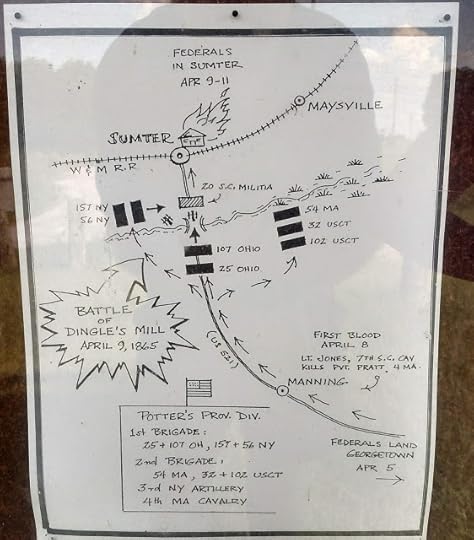 Map of the Battle of Dingle's Mill; the 157th New York hit the left flank of the 20th South Carolina Militia, perhaps 200 men in all.
Map of the Battle of Dingle's Mill; the 157th New York hit the left flank of the 20th South Carolina Militia, perhaps 200 men in all. When I struckthe solid ground with Co. C, I advanced to the edge of the woods west and sawacross an open field the earthwork referred to on a little knoll in the roadwith two pieces of cannon mounted in it. I saw at once (or thought I saw) if Icould form my company and charge across this field, I could take them in theflank and capture that battery before they could turn the pieces on us. I wouldbe charging along the hypotenuse of a triangle, the road being theperpendicular and the edge of the swamp along which the forward companies hadturned to the right being the short side.
I immediatelyformed my company in line, a few of the 56th New York boys fallingin line with me, and marched them hurriedly to the edge of the woods, showedthem the guns, then said, “Boys, let’s take them. Now, every man for himself asfast as you can go. Forward march!” And away we went. How rapidly a man’sthoughts will come to him under certain circumstances. I remember I thought aswe were running forward that the muzzles of those guns were large enough forone to crawl into and I expected every second to see them fire into our faces.
The distance was perhaps 200yards but the Johnnies had gotten scared and attempted to hitch their horses tothose guns and haul them off, but we were too near them and they cut the tracesof those that were hitched and away they went. Their traces were cotton ropes.Some ran up the road west, some climbed the road fence and scattered into afield north. A squad of cavalry was in the road only a few rods away and as werushed over that little fort, they all fled up the road. I was among the firstto arrive and shook hands with one of the 56th New York boys acrossone of the cannons.
We did not stop but for a momentin the redoubt. I rushed my men forward up the road a few hundred yards anddeployed them as skirmishers across the road and in the field to the north andsouth. As I was passing through the earthwork, one of my men picked up ablanket roll fastened with a shawl strap lying beside a dead lieutenant andhanded it to me saying, “Captain, this will keep you warm at night.” When Iunrolled that blanket, I found it was a lap robe, black on one side and greenon the other. I kept this and brought it home with me, using it for years. Ifound also in this roll a pair of cotton drawers and an undershirt which Igladly put on in exchange for the wet and muddy ones I was wearing. The rollalso contained a sick leave of absence signed by General Lee for thislieutenant. I kept this paper a long time and presume I now have it somewhereamong my papers but in the confusion incident to moving, I have mislaid it andcannot insert a copy of it here.
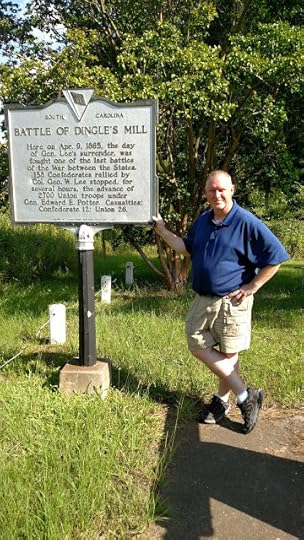 Yours truly at Dingle's Mill; signs on the site state to keep a close eye out for snakes but I never saw one, probably a good thing given my general distaste for reptiles.
Yours truly at Dingle's Mill; signs on the site state to keep a close eye out for snakes but I never saw one, probably a good thing given my general distaste for reptiles. Almost immediately after Co. Chad passed up the road, the other part of the regiment came charging up andcharged that battery again. In the fight of Dingle’s Mill or Sumter, Co. I borethe brunt of the fighting. Our regiment suffered 10 casualties, the 56thNew York, 15 and the 107th Ohio another 11. I have no means ofknowing what loss we inflicted on the enemy but presume their loss was not sogreat as they had the advantage of us, fighting on the defensive, and wereprepared to fire on the head of our column as it emerged from the swamp. TheRebel lieutenant in command of the battery was killed and left in the redoubt. Wecaptured the two pieces of artillery with ammunition and took them along withus, having them to use during the entire expedition, and took them back toGeorgetown with us and turned them over to the government.
After taking possession of theartillery, we marched on and after dark camped in Sumter, the county seat ofSumter County. The citizens had planned to give their boys a banquet after theyhad driven the invading Yankees back, but some of those refreshments foundtheir way into the empty stomachs of those invading Yankees. The boys capturedlarge quantities of peanuts and cigars.
During the 10th ofApril, the command remained in the city. E.H. Smith of Co. D, 56thN.Y. went into the printing office, set up, and printed a one sheet paper whichhe called The Banner of Freedom dated Sumter, S.C., Monday morning,April 10, 1865. Among the items in this paper was an article entitled “Acts ofBravery” from which I quote:
“In the affairs of yesterday, agallant act of bravery was performed which is worthy of commendation. When theorder to charge and capture the Rebel battery was given, Private Nathan Morseof Co. D, 56th N.Y. advanced ahead of his company on a keen run,scaled the breastwork which concealed the artillery, found four Rebels in thefort and ordered them to surrender, which they did. Captain Saxton of Co. C,157th N.Y. was the next to scale the earthwork and he and PrivateMorse shook hands across the guns. They were all the time exposed to themusketry of the enemy and liable to be captured at any moment as the Rebelcavalry were only a few yards to their left. Both escaped.”
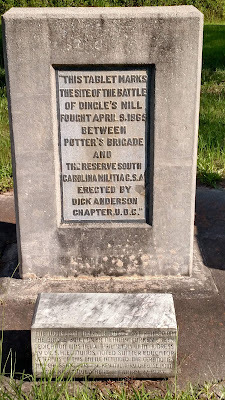 United Daughters of the Confederacy marker at Dingle's Mill.
United Daughters of the Confederacy marker at Dingle's Mill. In an editorial under the headof “The Duties of the Hour,” an address was made to the citizens of Sumter andto the whole state at large setting before them the fact that they had failedin their attempt to destroy the union by seceding therefrom. That they hadfought well and bravely, worthy of a better cause, but now they were beaten andthe union would be preserved. How would they accept the inevitable? They wereexhorted to take a common sense view of their conditions and yield gracefullyto the authority of the United States. It was believed if they would sue tocome back under the protecting folds of the stars and stripes and makeapplication for protection to the commander of the department, a guard would begranted them which would secure their persons and property against allguerillas or others who might seek to take advantage of the times to injurethem. A goodly number of copies of this paper were printed and distributed tothe houses of the city.
Sources:
War Reminiscences of Captain William Saxton, Co. C, 157thNew York Volunteer Infantry, Edgar Post (Nebraska), January 17, 1902,pg. 1; also, January 24, 1902, pg. 1
Daniel A. Masters's Blog
- Daniel A. Masters's profile
- 1 follower



